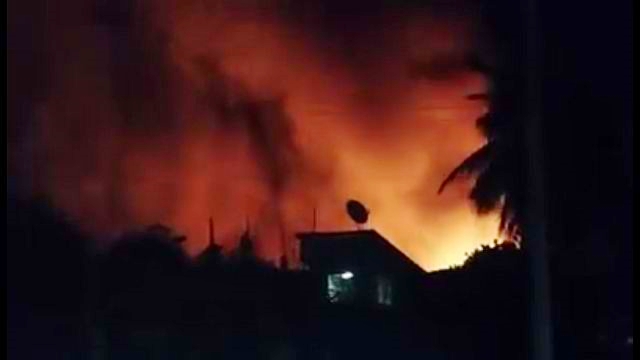Homes turned into ash as fire hits Lapu-lapu City in Cebu province.
A total of 100 houses were totally destroyed by fire that hit Sitio Arca, Barangay Pusok, Lapu-lapu City in Cebu on Monday night.
Fire Officer 1 Jopet Opeña said that they received the fire call at 9:49 PM and despite immediate response, the fire was controlled by 11:00 PM but was only declared fire out at 4:00 AM on Tuesday.

The fire alarm was escalated to Task Force Charlie where the Bureau of Fire Protection (BFP) stations in neighboring towns and cities were called for help. About 30 fire trucks from as far as Talisay City responded to the fire site.
The destroyed houses were made from light materials which were easily caught by fire. The strong winds helped blow the fire up and made it hard for firemen to control the situation.
Sitio Arca is mostly inhabited by boarders from the Mactan Export Processing Zone. The barangay officials are going to meet on Tuesday to place the fire site under calamity status.

The affected families were forced to evacuate and are now seeking shelter at Pusok Elementary at National High School and gym as well as a multipurpose hall below the Fernan bridge to house the displaced fire victims. The City Social Welfare Office to provide meals for the fire victims.
The BFP-Lapu-lapu is still conducting investigation as to the origin of fire and the extent and amount of damage it has caused.
But the residents alleged that the fire might have been caused by an explosion of damaged butane canisters.
Butane is a gas at room temperature and atmospheric pressure. Normal butane can be used for gasoline blending, as a fuel gas, either alone or in a mixture with propane, and as a feedstock for the manufacture of ethylene and butadiene, a key ingredient of synthetic rubber. Isobutane is primarily used by refineries to enhance (increase) the octane number of motor gasoline.
Inhalation of butane can cause euphoria, drowsiness, narcosis, asphyxia, cardiac arrhythmia, fluctuations in blood pressure and temporary memory loss, when abused directly from a highly pressurized container, and can result in death from asphyxiation and ventricular fibrillation.
